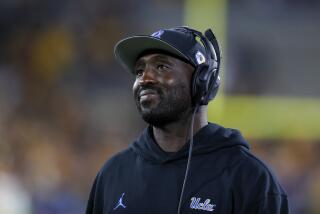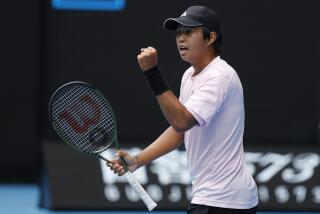DUTCH TREAT : Following a stop at BYU after leaving Amsterdam, lanky Robert Jan Bierens hopes that his powerful serve and volley carry him a lot further at UCLA.
- Share via
Robert Jan Bierens has traveled a long way to get where he wants to be--from Amsterdam in the Netherlands to Brigham Young University in Provo, Utah, and, finally, to UCLA.
His long arms and legs--and his powerful serve and volley--may carry him a lot further in collegiate and professional tennis.
The 6-6 1/2 Bierens is another top athlete from a foreign country who decided to let his athletic ability pay his way through college by getting a scholarship at an American university.
In Holland, as in many foreign countries, universities do not grant scholarships to athletes and do not have intercollegiate athletics. Foreign athletes, for the most part, have to decide whether they want to rise to the top rung in their sport by playing for club teams or for a sponsor, or whether to concentrate on getting a university education. It is difficult, if not impossible, for them to do both at the same time.
So after graduating from secondary school and a couple of years at an advanced technical school, Bierens, a highly ranked junior and senior tennis player, decided that he wanted to combine hitting the books and powering tennis balls, and that he could do so only in America.
In an interview at UCLA, Bierens said he originally went to Brigham Young on a scholarship because Hans Schmid, his coach in Holland, had been a teaching pro in Phoenix for years and while in America had gotten to know BYU Coach Larry Hall.
Hall apparently liked what he heard from Schmid and offered a scholarship to Bierens, who was 20 and had been ranked second nationally in Holland among 16-year-olds, third among 18-year-olds and eighth as a senior player.
In his first year at BYU, Bierens, now 22 and a redshirt junior at UCLA, lived up to Coach Hall’s expectations. Bierens said in his first college match he defeated Steve DeVries of UC Berkeley, then the top-ranked collegian who is now playing professionally. At the end of the 1986 season, Bierens reached the round of 16 players in singles to win All-American honors at the NCAA championships at the University of Georgia.
Although BYU was “a real good college,” Bierens felt that its isolated campus did not live up to his expectations as far as tennis action went.
He decided to try to transfer to UCLA because the school is “famous for its tennis program and coaching, and I felt that I could develop my game better there.”
“UCLA has very high academic standards, and after I finish school I either want to turn pro or go into business if I do not do well as a pro.”
Breaking into the ranks of the top pro players and making the big money is difficult, and he said he wants to complete his education before he attempts to go on the playing tour.
At his first NCAA championships, Bierens sought out UCLA Coach Glenn Bassett and sold himself to the UCLA mentor, now in his 22nd year with the Bruins.
“At the NCAAs, he came to me and said that he’d like to transfer to UCLA,” Bassett said. “It was a surprise because I didn’t even know of him.”
After getting to know Bierens, however, Bassett--whose teams have won seven NCAA championships--was happy to accommodate the lanky Dutchman and offered him a scholarship.
Because of NCAA transfer regulations, Bierens, a junior this year, could not play for the Bruins last season. But he has three years of college eligibility left.
Bierens made a fine debut in his first action with UCLA last October, when he played in a tournament in Manzanillo, Mexico, against the Mexican Davis Cup team. In singles, he advanced to the finals, where he lost to former USC star Jorge Lozano. And he and partner Buff Farrow won in doubles, beating teammates Patrick Galbraith and Brian Garrow, an All-American doubles team last year.
In two other tournaments, Bierens and Farrow did not do so well, which is one of the reasons they are Bassett’s No. 2 doubles team behind Galbraith and Garrow. “But they are very close to being No. 1,” Bassett said.
UCLA opened its dual-match season last week with an 8-1 victory over Cal Poly San Luis Obispo, and Bierens, playing No. 5 singles, defeated Dale Minney, 6-4, 7-6. He and Farrow also won their doubles match rather handily, defeating Neal Berryman and Joe McDonaugh, 6-1, 6-3.
Bassett likes what he has seen of Bierens. “He has a big serve, he brings the thing in, and that’s a big advantage,” Bassett said. He added that it is tough to get the ball by Bierens and his long arms when he comes to the net and difficult to get the ball over him on a lob.
But Bierens has the same problem that all big men seem to have in tennis. “He’s got to get a little bit faster,” Bassett said. “But he can be a top collegiate player and a good pro.
“He’s a hard worker, is very reliable and is enjoyable to have on the team.
“At BYU, with its high altitude and where its indoor courts (for winter play) are very fast, it was good for him. But he has to adapt to slower courts, and he’s trying hard,” he said.
The coach said Bierens had to be frustrated over taking last year off after transferring. At BYU, the Dutchman played No. 1 singles, but is No. 5 at UCLA, a blow to the ego that he “seems to be handling well,” Bassett said. “And here he is getting beat once in a while. Deep down inside that’s got to bother him.”
As a doubles team, Bierens and Farrow seem to have stepped out the comic pages. The tall Bierens is a perfect Jeff to the 5-7 Farrow’s Mutt.
Bassett said he has had similar doubles combinations who have met with success. They include the team of 6-5 Peter Fleming and 5-7 Ferdie Taygan, who won an NCAA doubles championship in 1976, and the duo of 6-4 Fritz Buehning and 5-6 Blaine Willenborg, who had a 20-2 doubles record at the No. 1 spot in 1979.
The advantages of such a combination, Bassett said, are that “the small guy is steady and the big guy has power. The small guy settles down the other, and the other has the power to put it away.”
This year’s big guy also likes the way he and Farrow combine. “Buff is fast, I have good reach. I have to power, he has to finesse,” Bierens said.
As for his singles game, Bierens said: “I can cover the net, and I have a good serve. But I have to work on my movement, and with low balls I have to bend more than others.
“I like hard courts better than clay,” he said, because balls have better bounce and the action is faster on hard courts, making the surface more suitable for his serve-and-volley game. “I like short points better than long ones,” he said.
Bierens said it was difficult for him to be out of action during the last college season. “The whole team would be psyched up for a match, but you’re not playing, you’re not involved. It was hard because I was excited to play.
“But I have three years left to play at UCLA, and that’s still a lot of time to improve my game before I go on the (pro) circuit.
“I’m not concerned about rankings and stuff. I want to improve my game and just be the best player I can be. If you work at your game, you’re going to win and get rankings.”
From Bassett, Bierens said he has learned how to “be disciplined and, that if you work hard, you can reach your goal, that you have to be mentally tough . . . (and) give 100% every day in practice.”
More to Read
Go beyond the scoreboard
Get the latest on L.A.'s teams in the daily Sports Report newsletter.
You may occasionally receive promotional content from the Los Angeles Times.






